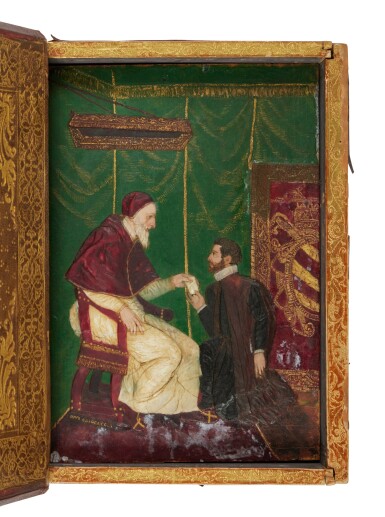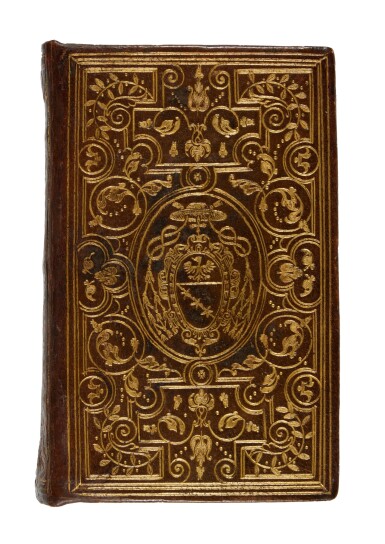Petrarca, Francesco. Il Petrarca nuouissimamente reuisto, e corretto da m. Lodouico Dolce. Con alcuni dottissimi auertimenti di m. Giulio Camillo et indici del Dolce de’ concetti, e delle parole che nel poeta si trouano, et in ultimo degli epiteti; et un utile raccolgimento delle desinenze delle rime di tutto il Canzoniere di esso poeta [part 2:] I Trionfi di m. Francesco Petrarca. Nuouamente ristampati, et con diligenza reuisti da m. Lodouico Dolce. Venice: Gabriele Giolito de Ferrari, 1558. [part 3:] Annotationi di m. Giulio Camillo sopra le rime del Petrarca. Tauola di m. Lodouico Dolce de i concetti. Venice: Gabriele Giolito de Ferrari, 1559
Second printing of Lodovico Dolce’s revised edition of the Sonetti, e canzoni, prefaced by his dedicatory letter to Zaccaria Delfino from the previous edition (subscribed Venice, 15 February 1553), and Alessandro Vellutello’s life of Petrarca and life of Laura. It is accompanied by Dolce’s edition of the Triumphi, with poems addressed to Petrarca by Geri Gianfigliazzi, Giovanni Dondi dall’Orologio, Senuccio del Bene Giacomo Colonna, and canzoni by Guido Cavalcanti, Dante Alighieri, Cino da Pistoia, and by Giulio Camillo’s annotations on the Rime, various lists and indexes.
This copy was bound at Venice in a style inspired by contemporary Ottoman bindings. The goatskin in the centers and corners of the covers was cut away and lined with blue-green silk, on which gold-painted gesso filigree is laid down. Hobson considers this and another binding in the Bibliotheca Brookeriana (to be offered in a future sale) as “faithful copies” of Ottoman exemplars, and remarks that most bindings of this type seem to have been sold ready bound by the Venetian booksellers, not commissioned by purchasers (Hobson & Culot, p. 52). In “A Binding for Philip II of Spain and its Ottoman Inspiration,” Nuria de Castilla examines the question of whether the Venetian binders “were relying on actual Ottoman bound manuscripts or on drawings when producing bindings which seem so close to the originals”(15th International Congress of Turkish Art: Proceedings [Ankara, 2018], pp. 197–205).
Comparable Bindings
(a) Constitutiones et decreta condita in provinciali synodo Mediolanensi (Venice: Paolo Manuzio, 1566). Bibliotheca Brookeriana (to be offered in a future sale).
Hobson, Humanists and Bookbinders, p. 150 (List G: Venetian filigree bindings of the sixteenth century, no. 11); Hobson & Culot, no. 19.
(b) Publio Francesco Spinola, Opera. Poematon libri III. Carminum libri IV. Epodon liber I. Carminum secularium liber I. Elegorum libri X. Hendecasyllaborum liber I. Epigrammaton libri III (Venice: Giordano Ziletti, 1563). Edouard Giard & Georges Andrieux, Vente d’un choix de livres précieux, portulan, manuscrits, incunables, reliures vénitiennes et aldines, livres à figures sur bois, illustrés du XVIIIe siècle, reliures aux armes ou ornées, Paris, 22 December 1927, lot 108. Current location untraced.Hobson & Culot, p. 53.
3 parts, 8vo (164 x 99 mm). Italic type, with roman, lines variable. collation: *8–***8, A–Z8, AA–BB8; *8–********8: 288 leaves. Title-page and both section-titles with woodcut Ferrari device and small woodcut frame, full-sheet topographical map of Provence (**4v–**5r), portrait of Petrarch and Laura facing each other followed by a quatrain within a woodcut border, (A3v), numerous woodcut initials, some historiated, type-ornament headpieces, larger printer's device on ********8v. (Some scattered light browning.)
binding: Venetian red goatskin (171 x 108 mm), ca. 1560, wide gilt fillet around sides, Persian-style filigree center- and corner-pieces of blue-green silk heightened by golden-yellow painted gesso, spine with 3 bands, edges gilt. (Worn, joints cracked, some minor repair.)
provenance: “G.A. Maÿer(?)” (unidentified seventeenth-century inscription on title-page) — Libreria antiquaria Hoepli & E. Aeschlimann, Zurich, 8–9 November 1928, lot 116 & Pl. 64, purchased by — unidentified owner — Libreria antiquaria Hoepli & E. Aeschlimann, Zurich, 14 October 1932, lot 74 & Pl. 27, purchased by — unidentified owner — Jean Fürstenberg (1890–1982) — Fondation Fürstenberg-Beaumesnil, Beaumesnil [Mesnil-en-Ouche] (Wemaëre-de Beaupuis-Denesle Enchères SARL & Binoche et Giquello, Paris, 9 December 2013, lot 144). acquisition: Purchased at the Fondation Fürstenberg-Beaumesnil sale through Robin Halwas.
references: Edit16 26293; USTC 847870; Bongi, Giolito de’ Ferrari, II, pp. 76-77; for the binding, see Musée d’art et d’histoire, Collection Jean Furstenberg: 3 mai–5 juin 1966 (Geneva, 1966), no. 69; De Marinis, Die italienischen Renaissance-Einbände der Bibliothek Fürstenberg (Hamburg, 1966), pp. 170–171; A. Hobson, Humanists and Bookbinders: The Origins and Diffusion of the Humanistic Bookbinding 1459–1559 (Cambridge, 1989), p. 150 (“List G. Venetian filigree bindings of the sixteenth century”, no. 10); A. Hobson & Culot, Italian and French 16th-Century Bookbindings (Brussels, 1991), p. 53.
Petrarca, Francesco. Il Petrarca nuouissimamente reuisto, e corretto da m. Lodouico Dolce. Con alcuni dottissimi auertimenti di m. Giulio Camillo et indici del Dolce de’ concetti, e delle parole che nel poeta si trouano, et in ultimo degli epiteti; et un utile raccolgimento delle desinenze delle rime di tutto il Canzoniere di esso poeta [part 2:] I Trionfi di m. Francesco Petrarca. Nuouamente ristampati, et con diligenza reuisti da m. Lodouico Dolce. Venice: Gabriele Giolito de Ferrari, 1558. [part 3:] Annotationi di m. Giulio Camillo sopra le rime del Petrarca. Tauola di m. Lodouico Dolce de i concetti. Venice: Gabriele Giolito de Ferrari, 1559
Second printing of Lodovico Dolce’s revised edition of the Sonetti, e canzoni, prefaced by his dedicatory letter to Zaccaria Delfino from the previous edition (subscribed Venice, 15 February 1553), and Alessandro Vellutello’s life of Petrarca and life of Laura. It is accompanied by Dolce’s edition of the Triumphi, with poems addressed to Petrarca by Geri Gianfigliazzi, Giovanni Dondi dall’Orologio, Senuccio del Bene Giacomo Colonna, and canzoni by Guido Cavalcanti, Dante Alighieri, Cino da Pistoia, and by Giulio Camillo’s annotations on the Rime, various lists and indexes.
This copy was bound at Venice in a style inspired by contemporary Ottoman bindings. The goatskin in the centers and corners of the covers was cut away and lined with blue-green silk, on which gold-painted gesso filigree is laid down. Hobson considers this and another binding in the Bibliotheca Brookeriana (to be offered in a future sale) as “faithful copies” of Ottoman exemplars, and remarks that most bindings of this type seem to have been sold ready bound by the Venetian booksellers, not commissioned by purchasers (Hobson & Culot, p. 52). In “A Binding for Philip II of Spain and its Ottoman Inspiration,” Nuria de Castilla examines the question of whether the Venetian binders “were relying on actual Ottoman bound manuscripts or on drawings when producing bindings which seem so close to the originals”(15th International Congress of Turkish Art: Proceedings [Ankara, 2018], pp. 197–205).
Comparable Bindings
(a) Constitutiones et decreta condita in provinciali synodo Mediolanensi (Venice: Paolo Manuzio, 1566). Bibliotheca Brookeriana (to be offered in a future sale).
Hobson, Humanists and Bookbinders, p. 150 (List G: Venetian filigree bindings of the sixteenth century, no. 11); Hobson & Culot, no. 19.
(b) Publio Francesco Spinola, Opera. Poematon libri III. Carminum libri IV. Epodon liber I. Carminum secularium liber I. Elegorum libri X. Hendecasyllaborum liber I. Epigrammaton libri III (Venice: Giordano Ziletti, 1563). Edouard Giard & Georges Andrieux, Vente d’un choix de livres précieux, portulan, manuscrits, incunables, reliures vénitiennes et aldines, livres à figures sur bois, illustrés du XVIIIe siècle, reliures aux armes ou ornées, Paris, 22 December 1927, lot 108. Current location untraced.Hobson & Culot, p. 53.
3 parts, 8vo (164 x 99 mm). Italic type, with roman, lines variable. collation: *8–***8, A–Z8, AA–BB8; *8–********8: 288 leaves. Title-page and both section-titles with woodcut Ferrari device and small woodcut frame, full-sheet topographical map of Provence (**4v–**5r), portrait of Petrarch and Laura facing each other followed by a quatrain within a woodcut border, (A3v), numerous woodcut initials, some historiated, type-ornament headpieces, larger printer's device on ********8v. (Some scattered light browning.)
binding: Venetian red goatskin (171 x 108 mm), ca. 1560, wide gilt fillet around sides, Persian-style filigree center- and corner-pieces of blue-green silk heightened by golden-yellow painted gesso, spine with 3 bands, edges gilt. (Worn, joints cracked, some minor repair.)
provenance: “G.A. Maÿer(?)” (unidentified seventeenth-century inscription on title-page) — Libreria antiquaria Hoepli & E. Aeschlimann, Zurich, 8–9 November 1928, lot 116 & Pl. 64, purchased by — unidentified owner — Libreria antiquaria Hoepli & E. Aeschlimann, Zurich, 14 October 1932, lot 74 & Pl. 27, purchased by — unidentified owner — Jean Fürstenberg (1890–1982) — Fondation Fürstenberg-Beaumesnil, Beaumesnil [Mesnil-en-Ouche] (Wemaëre-de Beaupuis-Denesle Enchères SARL & Binoche et Giquello, Paris, 9 December 2013, lot 144). acquisition: Purchased at the Fondation Fürstenberg-Beaumesnil sale through Robin Halwas.
references: Edit16 26293; USTC 847870; Bongi, Giolito de’ Ferrari, II, pp. 76-77; for the binding, see Musée d’art et d’histoire, Collection Jean Furstenberg: 3 mai–5 juin 1966 (Geneva, 1966), no. 69; De Marinis, Die italienischen Renaissance-Einbände der Bibliothek Fürstenberg (Hamburg, 1966), pp. 170–171; A. Hobson, Humanists and Bookbinders: The Origins and Diffusion of the Humanistic Bookbinding 1459–1559 (Cambridge, 1989), p. 150 (“List G. Venetian filigree bindings of the sixteenth century”, no. 10); A. Hobson & Culot, Italian and French 16th-Century Bookbindings (Brussels, 1991), p. 53.















Testen Sie LotSearch und seine Premium-Features 7 Tage - ohne Kosten!
Lassen Sie sich automatisch über neue Objekte in kommenden Auktionen benachrichtigen.
Suchauftrag anlegen